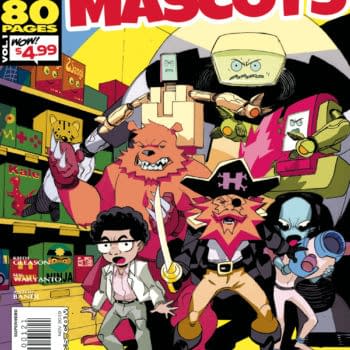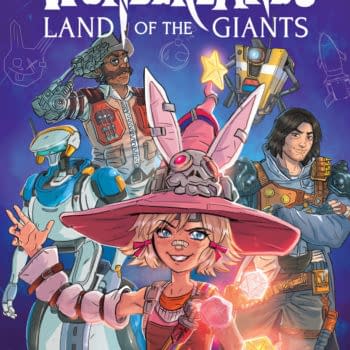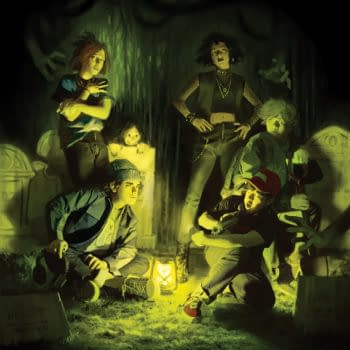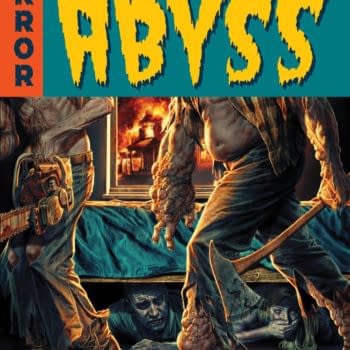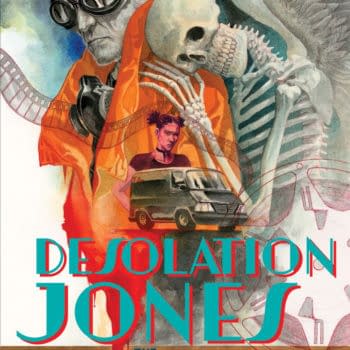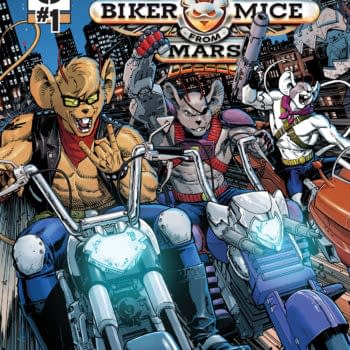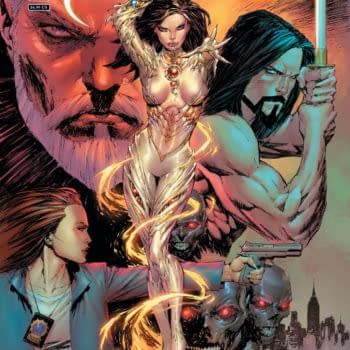Posted in: Comics, Recent Updates | Tagged: 99, anthony del col, arabic, archaia entertainment, archaia studios press, Artifacts, barack obama, battlestar galactica, bollywood, borders, china, conor mccreery, d&d, darth vader, dubai, dungeons & dragons, ea games, india, indian, islam, japan, jason momoa, Jinnrise, kill shakespeare, las vegas, mark sheppard, max landis, mouse guard, new jersey, new york comic con, nintendo, NYCC, pakistan, planet of the apes, president obama, san diego comic con, sdcc, selfmadehero, sony, spider-man, udon, warhammer
Mr. Smylie Goes to Dubai: Reflections on Middle East Film & Comic-Con
My longtime pal Mark Smylie dropped me a line recently, indicating that he'd just been to the MEFCC convention in Dubai and that he was wondering if Bleeding Cool would like to post his reflections on the event. Certainly we would! Mark Smylie, for those of you who are not aware, is the founder of Archaia Entertainment (formerly Archaia Studios Press), and the talented writer and artist behind the ARTESIA series. He's one of this industry's true gentlemen, the consummate professional and master of the craft. Plus, he once paid me to go hang out in Sin City, so that's pretty cool. So, without further ado, here's Mr. Smylie and some gorgeous pictures (courtesy of Monika Broz) of a faraway land…
I've been to a couple of pretty bad first conventions – the first Boston "National" shortly after 9/11 back in 2001, where I'm pretty sure the retailers outnumbered the attendees, and the first Las Vegas "Extrosion" Comic-Con back in, if I remember correctly, 2003, both come to mind – where you know within a few hours that not only is it the first show of its kind but it's also the last. And I've been lucky enough to attend a few first shows, most memorably the insanely crazy first New York Comic-Con at the Javitz in 2006, and now the first Middle East Film & Comic-Con held this past weekend in Dubai in the United Arab Emirates, where the energy and passion of the attendees made you instantly know that there would be many, many more to come.


I arrived in Dubai to exhibit at and scout the convention not knowing what to expect, as my only experience of Dubai prior to my arrival was watching Mission Impossible: Ghost Protocol on the plane over. Dubai is a fascinating city that instantly contradicts many of the stereotypes the western world holds of the Middle East and Arab culture. It is cosmopolitan, urbane, and for the most part intensely modern, and the state of its streets and infrastructure actually made me a bit jealous (smooth highways, unlike the pothole filled lanes of my local streets, and a gleaming train system that looked like it's straight out of a scifi film). The skyscrapers that spring up out of the desert landscape (unlike in most US cities they aren't surrounded by smaller buildings, so when you are near them you get an uninterrupted view of their architecture) seem to be competing in some competition for the best and newest in contemporary urban design. Dubai is a city of firsts and extremes: the tallest building in the world (the Burj Khalifa), the biggest shopping mall in the world (the Dubai Mall), the second biggest shopping mall in the world (the Mall of the Emirates).

I'm from New Jersey, and New Jerseyans know malls, and I can say with some confidence that the many malls in Dubai are stunning in their size and in their offerings; it's like someone took every shop on Fifth Avenue in New York City and rolled them up into a shopper's wet dream. In the Mall of the Emirates we ate at a restaurant overlooking an indoor ski slope, and in the Dubai Mall we were entertained by a giant indoor aquarium, three stories tall, held behind the largest single piece of acrylic glass in the world (we counted eight different varieties of shark swimming amongst the various fish, rays, and scuba divers). Everyone speaks English (it is mandatory in schools) and English serves as the lingua franca, as only about 1 in 8 people in the UAE are actually native locals, the vast majority being guest workers from India, Pakistan, Indonesia, China, and other points East, as well as a huge number of expat Westerners. I don't believe I've ever been in a foreign country where I was utterly at ease without knowing a single word of the local language; the city was so filled with Western chain restaurants that it was actually difficult to find restaurants that served local Arab cuisine (the closest thing we could find, really, were mostly Lebanese restaurants). The entire city seems a monument to capitalism, commerce, and consumer culture.

As an history buff I looked for some evidence of ancient Dubai, and found token evidence of it in the Dubai Museum, located in the historic Al Fahidi Fort, in the old souks (bazaars and marketplaces) that were preserved around Dubai Creek, and in the style of older mosques scattered throughout the city; but unlike in Europe, where history tends to be everywhere, the city of Dubai seemed quite intent on leaving its past behind and in embracing at every turn a rich and abundant future. The only American city I can think to compare it to is Las Vegas, which while it tips its hat to "old" Vegas and classic 50s style is a city gripped by a constant and persistent amnesia of sorts; what happens in Vegas stays in Vegas because it is a city without memory, where people go to forget themselves, reinvent themselves, indulge themselves without guilt. Dubai has that same vibe, if perhaps a tiny bit out of date – I don't think I've heard more 80s music of late than during our brief stay in Dubai, and the style of the city and its inhabitants seemed to flash a lot of mainstream '80s and '90s excess; it's a culture pre-bust, still in its boom years build-up, where Gordon Gekko would feel totally at home. No downscale ironic hipsters need apply.

But there was still some evidence of the more traditional parts of Islamic and Arabic culture peeking their way into the modern urban landscape. At the entrance to the malls we visited were signs (in English and Arabic) requesting respect for local traditions – so no hand-holding (dating is still apparently a vexed topic for young Emiratis, more on that in a bit), no kissing in public, no exposed knees or shoulders, no super-tight clothing, etc. – though we saw many (mostly Western) young women walking around in short shorts and mini-skirts (without incident). Women working in stores were actually quite rare, particularly in the older parts of the city, where every shop was staffed by men (mostly Indian and Pakistani, it seemed, to judge by the languages being spoken and restaurants available). And the convention itself provided some interesting tableaus matching new and old.

The first Middle East Film & Comic Convention, organized by Ben Caddy (a British expat) and Arafaat Ali Khan (a Pakistani who moved to Dubai with his family when he was 6) from the Dubai PR/event planners outfit Extracake, was held at the Dubai International Marine Club. Like at San Diego Comic-Con, you could walk out the back of the (much smaller) hall and be treated to the sight of a small harbor filled with yachts. Two indoor floors and a larger outdoor festival area made up the main convention area, with outdoor tent pavilions for the panels and art workshops and a discreetly hidden beer garden (Dubai is officially a dry city in deference to Islamic traditions but alcohol is widely available through hotel bars).

Attendees were treated to what was, in effect, kind of a mini-con version of larger shows in the States: film and TV celebrities such as John Rhys-Davies, Laurie Holden, Jason Momoa, and Luciana Carro & Mark Sheppard from Battlestar Galactica; comic book and manga writers and artists such as Jeremy Hahn (Artifacts), Mark Sable (Hazed), Anthony Del Col & Conor McCreery (Kill Shakespeare), Alvin Lee (Streetfighter), Lee Townsend (Spider-Man), and Sonia Leong (SelfMadeHero's Manga Shakespeare line); exhibitors, retailers, and publishers from both the States and the Arab world; and a full-blown Artist Alley of local artists and craftspeople.

There were a number of local homegrown manga and comics publishers in attendance to promote their graphic novels, including a few by Arab-Americans, such as Chicago-born Merik Tadros' River Jordan, and Philly-based podcaster Sohaib Awan's comic Jinnrise.

The convention was quickly filled the moment the doors opened by an intriguing mix of people: expat Westerners looking for a taste of home culture; Arabs and foreign residents in western clothes; Arabs wearing traditional dress –either the dishdasha for men, with and without headdress, and the abaya for women (some with the face veil but most without); and cosplayers from all three groups. A retailer from a local clothing shop called Mr. Ben's Costume Closet reported that they had gotten in a huge selection of cosplay costumes a few weeks before the show and had sold out of everything, and the most intriguing visual images of the convention were largely provided by young women in their abayas, often flocking to take photos of the cosplayers or incorporating cosplay elements into their own abayas (one young woman was wandering about wearing a Darth Vader mask under her headscarf).

I'd guess that women made up half of the attendees to the convention, either on their own, in small groups, or as part of family groupings.

There were mixed-gender groups of young Arabs in their teens and 20s here and there, but most groups seemed to be single gendered. I was treated to a brief explanation of the perils of dating in modern Dubai by a young 20-something fellow named Ali (in, of all things, a heavy metal t-shirt) who was texting a girl he knew who was at the show; he wanted to go say hello to her, but it turned out that she was there with her father (a distinguished-looking older fellow in wire-rimmed glasses, dishdasha, and red-and-white checkered keffiyeh). Ali had not been introduced yet to her father, and so custom prevented him from speaking either to her while she was in her father's presence or directly to her father until he had been properly introduced. He waited to approach her until her father was off distracted by another booth.

The presence of so many women – young and old, in both traditional and Western garb – at the show was quite heartening; we got the distinct sense that they had not been told that geek stuff was mostly for guys.

This was almost certainly a result of the widespread presence and influence of manga and anime. A small aisle next to ours was largely dedicated to companies producing homegrown Arabic manga, and there was even a Japanese culture booth (that almost seemed to be sponsored by the Japanese government) set up where attendees could try out kimonos. Quite a number of young female Arab artists were set up in Artists Alley, wearing their abayas as they displayed samples of their work and took commissions for sketches; and as with their young counterparts in the States, they were largely imitating the manga style (indeed Artists Alley seemed to have more female artists then male).

American publishers seeking inroads to the Arabic youth market will have to compete with manga and anime here the same as back home and in Europe. At the largest bookstore in the area, Kinokuniya's book shop in the Dubai Mall, the manga section was equal in size to the traditional comics/graphic novel section – which in turn dwarfed the graphic novel sections in most US bookstores, if not in most comics specialty stores; it was an incredible and diverse display, and I found it bittersweet that Archaia titles were better represented on Kinokuniya's shelves and display tables than in many US bookstores.

Despite the fact that it was the first of its kind in the Middle East, the attendees very quickly adapted to the traditions of US-style comic book conventions: photographing people in costumes (including during the inaugural costume contest), getting sketches of their favorite characters from artists in Artists Alley, watching panels with film and TV stars, watching videos and films in the theaters and searching for comics and graphic novels to take home. In addition to the costume contest, Udon editor Joel Enos and I got to judge an art contest with some very nice entries (Joel commented that it was the first time he'd ever been to a convention where people were asking him for his autograph, so there's a few things they need to catch up on, perhaps).

And in addition to indulging their taste for comics and film and TV pop culture, a lot of people were also there to explore videogame exhibitions from Sony, Nintendo, and EA Games and connect with other gamers, both video and tabletop. A personal highlight of the show (well, aside from getting to talk to an Emirati Prince and his paparazzi entourage about our book Conspiracy of the Planet of the Apes) was speaking to one older Arabic gentleman in a dishdasha who had purchased the Mouse Guard Roleplaying Game box set at a store in Dubai; he explained his kids were bugging him to play it with him but he hadn't been able to really wrap his head around the rules because he was a D&D player and the Burning Wheel system was so foreign to him (I suggested the forums on the Burning Wheel website to help find advice on playing the game). Games Workshop was well represented at the show, with both a sales booth and with a miniatures gaming area where attendees were lining up to learn to paint miniatures from their Warhammer games.

We spoke to both native and expat RPG players who were there to demo RPGs in the Artist Alley area; they reported running into all sorts of people living in the region who said "I'm constantly looking for other gamers to play with," and they had signed up over 75 people for their gaming groups on the first day alone. That sense of networking, of giddy geeks discovering that they weren't alone, was a pervasive feeling throughout the show (and a stated goal of organizers Ben and Arafaat, and on that count they succeeded I think beyond their wildest expectations).

Despite the enormous enthusiasm shown by the attendees, there were a few doses of reality to report. Attendance was pretty healthy – we heard estimates of about 8000 people on the first day and then 6000 or so on day two; the organizers did a fantastic job for a first show but there were problems on the first day getting people into the site and so some potential visitors may have been turned away (hopefully as with the first NY Comic-Con that will only encourage pre-registration and attendance for next year's event). There were not yet very many local homegrown publishers and they seemed largely to be at the small press level, valiantly struggling in an emerging market – as could be expected given how little distribution comics and graphic novels have throughout the region.

Visitors came to the show from many surrounding Middle Eastern countries, including Saudi Arabia, Egypt, and Jordan (and indeed further afield from India and Pakistan) often complaining that comics and graphic novels were almost if not entirely unavailable in their native countries. But even in progressive Dubai there remains a nuts-and-bolts problem of distribution; the city currently has no comic book stores (though we heard that as many as three might open by the end of the year) and only a handful of (admittedly large and very well-stocked) bookstores and book chains to service the city and region (including Kinokuniya, Jashanmal, Borders – not connected to the US chain but using their name and logo under contract – and Virgin Megastores). And perhaps the trials and tribulations of Naif Al Mutawa's attempts to get print distribution for The 99, a comic book story drawing on many traditional Islamic elements that has been championed by President Obama amongst others but which was dropped by its US distributors, points to the continued suspicions and uncertainties regarding comics and graphic novels in the Middle East on the one hand and Arabic culture in the West on the other.
Despite those minor asterisks, the show was a resounding success and pointed to the enormous potential of a region in which so much of the population is under the age of thirty and eager for the kinds of content that they see coming in from the States, Europe, India's Bollywood, and Japan. As with the first NY Comic-Con at the Javitz in 2006, every single person that I asked "Do you want to come back next year?" immediately responded with an unreserved and enthusiastic "Yes!" – myself included.



